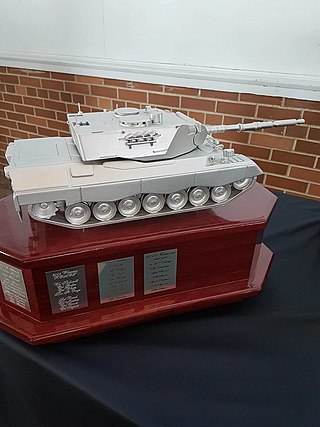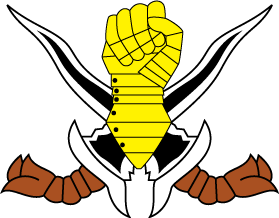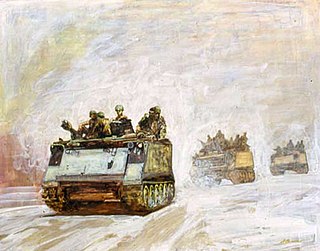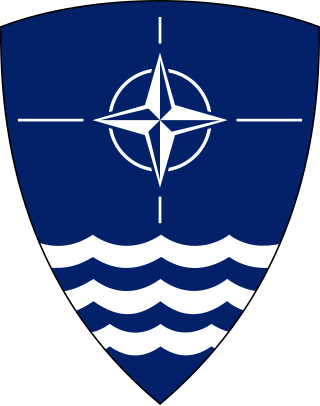
The Royal Armoured Corps is the armoured arm of the British Army, that together with the Household Cavalry provides its armour capability, with vehicles such as the Challenger 2 Tank and the Warrior tracked armoured vehicle. It includes most of the Army's armoured regiments, both the Royal Tank Regiment and those converted from old horse cavalry regiments. Today it comprises twelve regiments, eight regular and four reserve. Although the Household Cavalry Regiment provide an armoured regiment, they are not part of the RAC.

The Guard Hussar Regiment is a cavalry unit of the Royal Danish Army, whose primary task is to train the Guard Hussars for various functions in the mobilisation force. The Guard Hussar Regiment is one of two active cavalry regiments of the Danish Army, and was formed in 2001 through the amalgamation of the original Guard Hussars regiment, Zealand Life Regiment and Danish Life Regiment.

The Prince's Life Regiment was a Royal Danish Army infantry regiment. The motto of the regiment was "Gloria Finis".

The Danish International Brigade, short DIB was a Danish military brigade.

The Worthington Trophy is a Canadian military award. It was awarded annually to the best reserve armoured unit in the Canadian Land Forces. It is named after Major-General F. F. Worthington, known as Fighting Frank – "The Father of the Royal Canadian Armoured Corps".

The Funen Life Regiment was an infantry regiment of the Royal Danish Army. On 1 November 1991 it was merged with the King's Jutlandic Regiment of Foot, into Slesvigske Fodregiment.

The Danish Division, short DDIV, is the only remaining military land division in Denmark. It was created on 1 January 1997 as the successor of Jutland Division. It is one of the now-two Divisions of Multinational Corps North East, the German-Danish-Polish Corps, the successor to the former German-Danish Allied Land Forces Schleswig-Holstein and Jutland (LANDJUT), a NATO Allied Forces Northern Europe formation.

The Royal Armoured Corps or Kor Armor Diraja (KAD) is the armoured forces of the Malaysian Army.

Armoured cavalry are combat units using armoured fighting vehicles (AFVs) instead of horses. They began to replace horse cavalry in the heavy shock and the light reconnaissance, skirmishing and exploitation/pursuit roles in most armies commencing after the First World War.
During the Cold War, NATO and the Warsaw Pact both had large tank formations present in Europe.

The Schleswig Regiment of Foot is a Royal Danish Army infantry regiment. On 1 January 2001, the regiment was merged with the Queen's Life Regiment to form the Prince's Life Regiment. In 2018, it was announced that the regiment would be reestablished on 1 January 2019 as a light infantry battalion.
Armoured regiments are units provided by the Royal Armoured Corps of the British Army.

Armoured reconnaissance is the combination of terrestrial reconnaissance with armoured warfare by soldiers using tanks and wheeled or tracked armoured reconnaissance vehicles. While the mission of reconnaissance is to gather intelligence about the enemy with the use of reconnaissance vehicles, armoured reconnaissance adds the ability to fight for information, and to have an effect on and to shape the enemy through the performance of traditional armoured tasks.

Allied Forces Baltic Approaches (BALTAP) was a Principal Subordinate Command (PSC) of the NATO Military Command Structure, with responsibility for the Baltic Sea area. It was in existence from 1962 to 2002 and consisted of the Danish Armed Forces, units of the West German Bundeswehr and allied wartime reinforcements.

The Jutland Division was a mechanized infantry formation of the Danish Army during the Cold War. It was formed during 1951-1952 as 3rd Division from assets of the III Military Region and the division headquarters was initially located in Aabenraa. As initially formed, the division had only one active brigade and two reserve brigades. The division changed its name to "Jutland Division" in 1961. In 1975, the division headquarters was moved to Fredericia and the 2nd and 3rd Brigades received full equipment sets. By 1979, each brigade was made up of two mechanized infantry battalion, a tank battalion, a self-propelled artillery battalion, and an armored reconnaissance squadron (company). In 1981 the three armored reconnaissance squadron was merged into V/JDR Reconnaissance Battalion.
The full structure of the Polish Land Forces is:
The following is a hierarchical outline for the Danish armed forces at the end of the Cold War. It is intended to convey the connections and relationships between units and formations. In wartime all Danish military units would have come under the joint West German/Danish NATO command Allied Forces Baltic Approaches (BALTAP). BALTAP was a principal subordinate command under the Allied Forces Northern Europe Command (AFNORTH). The commander-in-chief of (BALTAP) was always a Danish Lieutenant General or Vice Admiral, who had the designation Commander Allied Forces Baltic Approaches (COMBALTAP). In peacetime BALTAP had only a few communication units allocated and all other units remained under national command of West Germany's Bundeswehr and Denmark's Forsvaret.

The Queen's Life Regiment was a Royal Danish Army infantry regiment. On 1 January 2001, it was amalgamated with the Prince's Life Regiment.
This article lists the structure of the Royal Danish Army in 1989 and in May 2020:














